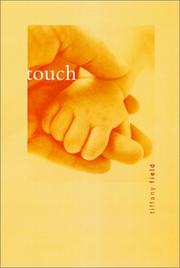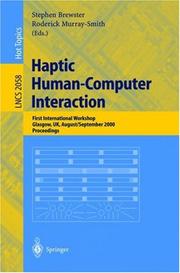| Listing 1 - 6 of 6 |
Sort by
|

ISBN: 2100057081 9782100057085 Year: 2001 Publisher: Paris: Dunod,
Abstract | Keywords | Export | Availability | Bookmark
 Loading...
Loading...Choose an application
- Reference Manager
- EndNote
- RefWorks (Direct export to RefWorks)
Book
Year: 2001 Publisher: [Place of publication not identified] Churchill Livingstone
Abstract | Keywords | Export | Availability | Bookmark
 Loading...
Loading...Choose an application
- Reference Manager
- EndNote
- RefWorks (Direct export to RefWorks)

ISBN: 0702026514 Year: 2001 Publisher: Edinburgh Baillière Tindall
Abstract | Keywords | Export | Availability | Bookmark
 Loading...
Loading...Choose an application
- Reference Manager
- EndNote
- RefWorks (Direct export to RefWorks)
Physiotherapy. Alternative treatments --- verpleegkunde --- alternatieve geneeswijzen --- Geneeswijzen --- Aromatherapie --- Counseling --- Muziektherapie --- Zingeving --- Stress --- Acupunctuur --- Biofeedback --- Sociale vaardigheden --- Communicatie --- Kruidengeneeskunde --- Homeopathie --- Hypnose --- Massage --- Natuurgeneeskunde --- Osteopathie --- Relaxatie --- Therapeutic touch --- Geneeswijze --- Sport

ISBN: 0262272598 058544661X 026206216X 0262561565 9780262272599 9780585446615 9780262062169 9780262561563 Year: 2001 Publisher: Cambridge, Mass. : MIT Press,
Abstract | Keywords | Export | Availability | Bookmark
 Loading...
Loading...Choose an application
- Reference Manager
- EndNote
- RefWorks (Direct export to RefWorks)
An essay on the importance of touch to children's growth and development and to the physical and mental well-being of people of all ages.The first sensory input in life comes from the sense of touch while a baby is still in the womb, and touch continues to be the primary means of learning about the world throughout infancy, well into childhood. Touch is critical for children's growth, development, and health, as well as for adults' physical and mental well-being. Yet American society, claims Tiffany Field, is dangerously touch-deprived.Field, a leading authority on touch and touch therapy, begins this accessible book with an overview of the sociology and anthropology of touching and the basic psychophysical properties of touch. She then reports recent research results on the value of touch therapies, such as massage therapy, for various conditions, including asthma, cancer, autism, and eating disorders. She emphasizes the need for a change in societal attitudes toward touching, particularly among those who work with children.
Touch --- Massage therapy --- Massage --- Therapeutic Touch --- Musculoskeletal Manipulations --- Mind-Body Therapies --- Spiritual Therapies --- Complementary Therapies --- Physical Therapy Modalities --- Therapeutics --- Analytical, Diagnostic and Therapeutic Techniques and Equipment --- Psychology --- Social Sciences --- Psychological aspects --- Therapeutic use --- Therapy --- Treatment --- Therapeutic --- Therapies --- Treatments --- Disease --- Neurological Physiotherapy --- Neurophysiotherapy --- Physical Therapy Techniques --- Physiotherapy (Techniques) --- Modalities, Physical Therapy --- Modality, Physical Therapy --- Physical Therapy Modality --- Physical Therapy Technique --- Physiotherapies (Techniques) --- Physiotherapy, Neurological --- Techniques, Physical Therapy --- Alternative Therapies --- Therapy, Alternative --- Therapy, Complementary --- Alternative Medicine --- Complementary Medicine --- Medicine, Alternative --- Medicine, Complementary --- Therapies, Alternative --- Therapies, Complementary --- Exorcism --- Therapies, Spiritual --- Spiritual Healing --- Exorcisms --- Healing, Spiritual --- Healings, Spiritual --- Spiritual Healings --- Mind-Body Medicine --- Mind Body Medicine --- Mind Body Therapies --- Mind-Body Therapy --- Therapies, Mind-Body --- Therapy, Mind-Body --- Manipulative Therapies --- Manual Therapies --- Therapy, Manipulation --- Manipulation Therapy --- Manipulations, Musculoskeletal --- Manipulation Therapies --- Manipulative Therapy --- Manual Therapy --- Therapies, Manipulation --- Therapies, Manipulative --- Therapies, Manual --- Therapy, Manipulative --- Therapy, Manual --- Touch, Therapeutic --- Laying-on-of-Hands --- Reiki --- Bodywork --- Craniosacral Massage --- Massage Therapy --- Rolfing --- Therapy, Zone --- Reflexology --- Zone Therapy --- Bodyworks --- Massage Therapies --- Massage, Craniosacral --- Therapies, Massage --- Therapies, Zone --- Therapy, Massage --- Zone Therapies --- Therapeutic massage --- Healing touch --- Imposition of hands --- Therapeutic touch --- therapy --- massage --- aanraken --- Postoperative Care --- Physical Therapist Assistants --- Occultism --- Parapsychology --- Spirituality --- Therapeutics, Physiological --- Energy medicine --- Physiotherapy. Alternative treatments --- kinesitherapie --- Group Physiotherapy --- Group Physiotherapies --- Physiotherapies, Group --- Physiotherapy, Group --- Massage therapy. --- Psychological aspects. --- Therapeutic use. --- COGNITIVE SCIENCES/Psychology/Cognitive Psychology --- Therapeutic Touch. --- Massage. --- Toucher --- Massothérapie --- Aspect psychologique --- Emploi en thérapeutique

ISBN: 0691092737 1282259334 9786612259333 1400830834 0691004889 9781400830831 9780691004884 Year: 2001 Publisher: Princeton, N.J. : Princeton University Press,
Abstract | Keywords | Export | Availability | Bookmark
 Loading...
Loading...Choose an application
- Reference Manager
- EndNote
- RefWorks (Direct export to RefWorks)
The tobacco plant synthesizes nicotine to protect itself from herbivores. The female moth broadcasts sex pheromones to attract a mate, while a soldier ant deploys an alarm pheromone to call for help. The carbon dioxide on a mammal's breath beckons hungry ticks and mosquitoes, while a flower's fragrance speaks to the honey bee. Indeed, much of the communication that occurs within and between various species of organisms is done not by sight, sound, or touch, but with chemicals. From mating to parenting, foraging to self-defense, plant and animal activities are accomplished largely by the secretion or exchange of organic chemicals. The fascinating and fast-developing science that encompasses these diverse phenomena is introduced here, by William Agosta, in a series of remarkable stories absolutely accessible to the general reader yet revelatory to chemists and biologists. Among Agosta's characters are the organisms that steal, counterfeit, or interpret the chemical signals of other species for their own ends. We learn of seeds that mimic ant odors to facilitate their own dispersion and flies that follow the scent of truffles to lay their eggs. We read about pit vipers that react in terror when their flicking tongues detect a king snake, and slave-making ants incapable of finding their own food. And we meet ice-age people who ate birch fungus to relieve whipworms and early human hunters who used the urine of wolves to maneuver deer to favorable sites. Agosta also chronicles the rapid development of the applied science that makes use of chemical ecology. As researchers deepen our understanding of the biological world, they are making economically significant discoveries (such as enzymes that remain stable in extreme heat), finding ways to reduce our reliance on manufactured pesticides, identifying new uses for traditional medicines, and developing sophisticated new pharmaceuticals effective in treating malaria and several cancers. On the horizon are antiviral agents derived from the chemical defenses of marine species. From the exploits of flies to the high-stakes effort to cure human disease, Agosta's tour of chemical ecology grants any reader entrance to the invisible realm where chemistry determines life and death.
574 --- 57.044 --- 57.026 --- 577.19 --- 591.58 --- 581.57 --- 581.57 Means of protection. Means of attraction. Adaptations for self-preservation --- Means of protection. Means of attraction. Adaptations for self-preservation --- 591.58 Communication and expression by sound or ultrasonic vibrations, mime or other signals, smell, touch or chemical sense (chemoreception) --- Communication and expression by sound or ultrasonic vibrations, mime or other signals, smell, touch or chemical sense (chemoreception) --- 577.19 Pheromones and phytocins --- Pheromones and phytocins --- 57.026 Social processes and behaviour. --- Social processes and behaviour. --- 57.044 Chemical factors --- Chemical factors --- 574 General ecology. Biocoenology. Hydrobiology. Biogeography --- General ecology. Biocoenology. Hydrobiology. Biogeography --- Chemoecology --- Ecologie chimique --- Chemical ecology. --- Ecology --- Metabolites --- Chemosensory ecology

ISBN: 3540423567 3540445897 Year: 2001 Publisher: Berlin, Heidelberg : Springer Berlin Heidelberg : Imprint: Springer,
Abstract | Keywords | Export | Availability | Bookmark
 Loading...
Loading...Choose an application
- Reference Manager
- EndNote
- RefWorks (Direct export to RefWorks)
Haptic human-computer interaction is interaction between a human computer user and the computer user interface based on the powerful human sense of touch. Haptic hardware has been discussed and exploited for some time, particularly in the context of computer games. However, so far, little attention has been paid to the general principles of haptic HCI and the systematic use of haptic devices for improving efficiency, effectiveness, and satisfaction in HCI. This book is the first one to focus on haptic human-computer interaction. It is based on a workshop held in Glasgow, UK, in August / September 2000. The 22 revised full papers presented were carefully reviewed and selected from 35 submissions. Besides a brief historic survey, the book offers topical sections on haptic interfaces for blind people, collaborative haptics, psychological issues and measurement, and applications of haptics.
Human-computer interaction --- Virtual reality --- Touch --- Computer Science --- Engineering & Applied Sciences --- Feeling --- Haptic sense --- Haptics --- Tactile perception --- Tactual perception --- Computer science. --- User interfaces (Computer systems). --- Artificial intelligence. --- Image processing. --- Education --- Computers and civilization. --- Computer Science. --- User Interfaces and Human Computer Interaction. --- Artificial Intelligence (incl. Robotics). --- Image Processing and Computer Vision. --- Computers and Society. --- Computers and Education. --- Data processing. --- Somesthesia --- Computer vision. --- Education. --- Artificial Intelligence. --- Children --- Education, Primitive --- Education of children --- Human resource development --- Instruction --- Pedagogy --- Schooling --- Students --- Youth --- Civilization --- Learning and scholarship --- Mental discipline --- Schools --- Teaching --- Training --- Machine vision --- Vision, Computer --- Artificial intelligence --- Image processing --- Pattern recognition systems --- AI (Artificial intelligence) --- Artificial thinking --- Electronic brains --- Intellectronics --- Intelligence, Artificial --- Intelligent machines --- Machine intelligence --- Thinking, Artificial --- Bionics --- Cognitive science --- Digital computer simulation --- Electronic data processing --- Logic machines --- Machine theory --- Self-organizing systems --- Simulation methods --- Fifth generation computers --- Neural computers --- Informatics --- Science --- Optical data processing. --- Education—Data processing. --- Civilization and computers --- Optical computing --- Visual data processing --- Integrated optics --- Photonics --- Computers --- Interfaces, User (Computer systems) --- Human-machine systems --- Optical equipment
| Listing 1 - 6 of 6 |
Sort by
|

 Search
Search Feedback
Feedback About
About Help
Help News
News